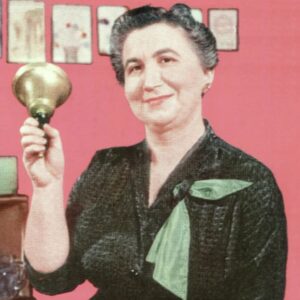Before there was “Sesame Street” …
Before there was “Mister Rogers’ Neighborhood” …
Before there was “Romper Room” …
Before there was “Captain Kangaroo” …
There was Miss Frances and “Ding Dong School.” The show not only was the first in its genre, it literally created children’s television — and it set the bar very high, too. Let’s hop into the Wayback Machine and revisit 1952.
Television was brand new back then. TV stations were launching all over the country, and big, cumbersome televisions were popping up inside more and more American homes.
Judith Waller was the public service and educational programming director at WNBQ-TV in Chicago. Most local stations produced hours of programming daily, far more than they do now. As Waller was talking with her boss one day, he noted that with the Baby Boom in full swing, there were more than 235,000 preschool children in the Chicago area. Then he pointedly asked, “What are you going to do about it?”
Waller rolled into action. She devised a nursery school program designed to teach tykes watching at home. Because viewers would be little people, the show used six cameras that shot from angles toddlers would see. All props would be easily recognizable to little children.
Auditions were held for the program’s host. Frances Horwich was one of the educators who tried out for the gig. A woman of a certain age with a kindly disposition, she headed a local college’s education department. She lacked showbiz experience but had once taught nursery school. While being alone on set for a full hour each day scared her, she thought, “Why not?” and gave it a try.
She was soon hired to be “Miss Frances,” AND then successfully negotiated to own the rights to the show. When the producer’s 3-year-old son was told each episode would begin with an old-fashioned teacher’s desk bell ringing, he blurted out, “Ding Dong Show!” They had the program’s title.
A pilot episode was filmed. One horrified station executive said the show was so bad it would kill television and make viewers listen to the radio again. So it was decided to air the program just once. WNBQ didn’t issue a press release announcing it or promoting it in any way. They figured they’d let it die of its own embarrassment.
And so, with no fanfare, “Ding Ding School” made its debut on Thursday morning, October 2, 1952. Primitive by today’s hi-tech standards, it began with a closeup of Miss Frances’ hand ringing the aforementioned bell, followed by a cheesy studio organ playing the show’s equally cheesy theme song. Miss Frances sang in a warbly voice that was better suited for a country church choir than television:
“I’m your school bell
ding dong ding;
boys and girls
all hear me ring.
Every time I
ding dong ding,
come with me
to play and sing.”
Then she jumped into the lesson. Miss Frances talked like she was speaking to actual children. “How are you, boys and girls? What are you doing today? (Pause.) Really? That’s good!”
WNBQ’s big brass cringed for an hour until the show ended. No one expected what came next. The station’s switchboard was flooded with more than 150 calls in 45 minutes as parents told how their kids loved the program. That was nothing compared to the tidal wave of enthusiastic fan mail that followed.
“Ding Dong School” instantly became part of WNBQ’s morning lineup five days a week. It was such a hit that NBC picked it up in 1953 and broadcast it nationally. Miss Frances even became a TV star. More than 12,000 children and parents attended a promotional event in Boston. When she and her husband flew to Florida for a vacation, kids on the plane recognized her — and sang the show’s theme song over and over all the way to Miami. (Likely making it history’s most miserable flight for the other passengers.)
But TV is a cutthroat business. Despite its success, NBC canceled “Ding Dong School” in 1956 for the more lucrative “The Price Is Right.” The show continued in syndication until 1965.
Miss Frances eventually moved to Arizona, where she dabbled in local public television until her death in 2001 at age 94.
Children’s television is one of broadcasting’s few success stories. And it’s largely due to the huge influence of a teacher and her little bell.
Please follow DVJournal on social media: Twitter@DVJournal or Facebook.com/DelawareValleyJournal

